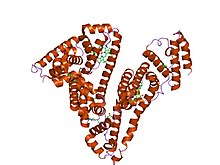| Serum albumin family | |||||||||||
|---|---|---|---|---|---|---|---|---|---|---|---|
 Structure of human serum albumin.[1] | |||||||||||
| Identifiers | |||||||||||
| Symbol | Serum_albumin | ||||||||||
| Pfam | PF00273 | ||||||||||
| Pfam clan | CL0282 | ||||||||||
| InterPro | IPR014760 | ||||||||||
| SMART | SM00103 | ||||||||||
| PROSITE | PS51438 | ||||||||||
| SCOP2 | 1ao6 / SCOPe / SUPFAM | ||||||||||
| |||||||||||
Serum albumin, often referred to simply as blood albumin, is an albumin (a type of globular protein) found in vertebrate blood. Human serum albumin is encoded by the ALB gene.[2][3][4] Other mammalian forms, such as bovine serum albumin, are chemically similar.
Serum albumin is produced by the liver, occurs dissolved in blood plasma and is the most abundant blood protein in mammals. Albumin is essential for maintaining the oncotic pressure needed for proper distribution of body fluids between blood vessels and body tissues; without albumin, the high pressure in the blood vessels would force more fluids out into the tissues. It also acts as a plasma carrier by non-specifically binding several hydrophobic steroid hormones and as a transport protein for hemin and fatty acids. Too much or too little circulating serum albumin may be harmful. Albumin in the urine usually denotes the presence of kidney disease. Occasionally albumin appears in the urine of normal persons following long periods of standing (postural albuminuria).
- ^ Sugio S, Kashima A, Mochizuki S, Noda M, Kobayashi K (June 1999). "Crystal structure of human serum albumin at 2.5 A resolution". Protein Engineering. 12 (6): 439–46. doi:10.1093/protein/12.6.439. PMID 10388840.
- ^ Hawkins JW, Dugaiczyk A (1982). "The human serum albumin gene: structure of a unique locus". Gene. 19 (1): 55–8. doi:10.1016/0378-1119(82)90188-3. PMID 6292049.
- ^ Harper ME, Dugaiczyk A (July 1983). "Linkage of the evolutionarily-related serum albumin and alpha-fetoprotein genes within q11-22 of human chromosome 4". American Journal of Human Genetics. 35 (4): 565–72. PMC 1685723. PMID 6192711.
- ^ "Entrez Gene: albumin". U.S. National Library of Medicine.